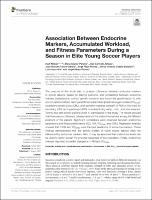Por favor, use este identificador para citar o enlazar este ítem:
https://repositorio.usj.es/handle/123456789/680
Registro completo de metadatos
| Campo DC | Valor | Lengua/Idioma |
|---|---|---|
| dc.contributor.author | Nobari, Hadi | - |
| dc.contributor.author | Mainer Pardos, Elena | - |
| dc.contributor.author | Adsuar, Jose C. | - |
| dc.contributor.author | Franco-García, Juan Manuel | - |
| dc.contributor.author | Rojo-Ramos, Jorge | - |
| dc.contributor.author | Cossio-Bolanõs, Marco Antonio | - |
| dc.contributor.author | Urzua-Alul, Luis A. | - |
| dc.contributor.author | Pérez-Gómez, Jorge | - |
| dc.date.accessioned | 2021-11-10T12:56:11Z | - |
| dc.date.available | 2021-11-10T12:56:11Z | - |
| dc.date.issued | 2021-08-31 | - |
| dc.identifier.citation | Nobari H, Mainer-Pardos E, Adsuar JC, Franco-García JM, Rojo-Ramos J, Cossio-Bolaños MA, Urzua Alul L and Pérez-Gómez J (2021) Association Between Endocrine Markers, Accumulated Workload, and Fitness Parameters During a Season in Elite Young Soccer Players. Front. Psychol. 12:702454. doi: 10.3389/fpsyg.2021.702454 | es_ES |
| dc.identifier.issn | 1664-1078 | es_ES |
| dc.identifier.uri | https://repositorio.usj.es/handle/123456789/680 | - |
| dc.description.abstract | The purpose of this study was to analyze differences between endocrine markers in soccer players, based on playing positions, and correlations between endocrine markers (testosterone, cortisol, growth hormone, and insulin-like growth factor-1), with accumulated workload training and fitness parameters [maximal oxygen uptake (VO2max), countermovement jump (CMJ), and isometric maximal strength (1-RM) of the knee for hamstring (ISH) and quadriceps (ISQ) muscles] during early-, mid-, and end-seasons. Twenty-four elite soccer players under 17 participated in this study. The results showed that there was no difference between levels of the endocrine markers among the different positions of the players. Significant correlations were observed between endocrines parameters and fitness performance (ISQ, ISH, VO2max, and CMJ). Regression analysis showed that 1-RM and VO2max were the best predictors of endocrine markers. These findings demonstrated that the activity profiles of youth soccer players were not influenced by endocrine markers. Also, it may be assumed that endocrines levels can be used to better explain the physical capacities of this population. Finally, endocrines markers may help to predict changes in 1-RM and VO2max. | es_ES |
| dc.format.extent | 14 | es_ES |
| dc.format.mimetype | application/pdf | es_ES |
| dc.language.iso | eng | es_ES |
| dc.publisher | Frontiers Media S.A. | es_ES |
| dc.relation.requires | Adobe | es_ES |
| dc.rights | Atribución 4.0 Internacional | * |
| dc.rights.uri | http://creativecommons.org/licenses/by/4.0/ | * |
| dc.subject | Training load | es_ES |
| dc.subject | Growth hormone | es_ES |
| dc.subject | Performance | es_ES |
| dc.subject | Testosterone | es_ES |
| dc.subject | 1-RM | es_ES |
| dc.subject | VO2max (maximal oxygen uptake) | es_ES |
| dc.title | Association Between Endocrine Markers, Accumulated Workload, and Fitness Parameters During a Season in Elite Young Soccer Players | es_ES |
| dc.type | info:eu-repo/semantics/article | es_ES |
| dc.relation.publisherversion | https://www.frontiersin.org/articles/10.3389/fpsyg.2021.702454/full | es_ES |
| dc.identifier.publicationfirstpage | 1 | es_ES |
| dc.identifier.publicationlastpage | 14 | es_ES |
| dc.identifier.doi | 10.3389/fpsyg.2021.702454 | es_ES |
| dc.rights.accessrights | info:eu-repo/semantics/openAccess | es_ES |
| Aparece en las colecciones: | Artículos de revistas | |
Ficheros en este ítem:
| Fichero | Descripción | Tamaño | Formato | |
|---|---|---|---|---|
| Association Between Endocrine Markers, Accumulated Workload, and Fitness Parameters During a Season in Elite Young Soccer Players.pdf | 2,11 MB | Adobe PDF |  Visualizar/Abrir |
Este ítem está sujeto a una licencia Creative Commons Licencia Creative Commons

